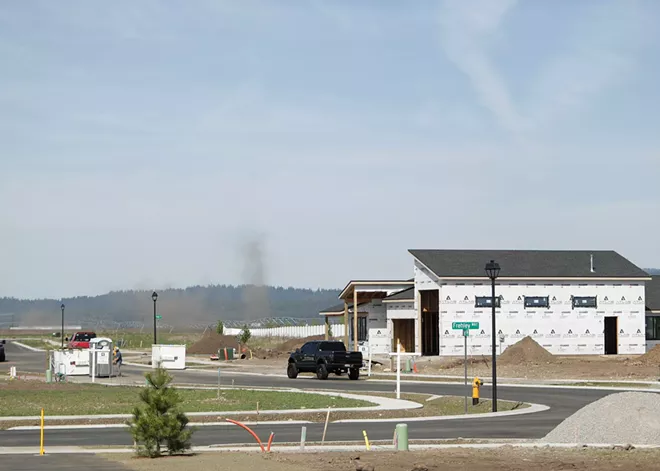
Currently, more than 188,000 people live in Kootenai County. The county's Metropolitan Planning Organization predicts that number will exceed 300,000 by 2040.
Local applications to subdivide land into smaller parcels to sell to developers have more than doubled in recent years.
Starting in 2028, the Idaho Transportation Department is planning to widen Interstate 90 between the state line and Coeur d'Alene to provide four lanes of traffic each way for the increased traffic.
As pressure to build mounts, so does the desire to protect agricultural land. Last year, the Idaho Legislature passed a bill that could protect farms or rangeland from being forcibly bought by local governments through an often unpopular executive power called "eminent domain." The use of eminent domain often signals — and facilitates — urban development.
In 2024, Idaho House Bill 608 established a process for farmers and ranchers to create their own agricultural protection areas — parcels of land exempted for 20 years to a city's or county's use of eminent domain. State and federal eminent domain remains unrestricted.
"Working farms, ranches, and forests and the benefits they provide to Idahoans are being lost to rapid population growth, conversion to development, and other uses in recent decades," the law states.
This year, Kootenai County added the applicable code and created an Agricultural Protection Area Commission in April as required by the new state law. But even though these protection areas have been discussed at the state level for over a year, Kootenai County commissioners and planners haven't received any applications or heard of any interest from farmers to create the county's first agricultural protection area.
Despite widespread pushback on growth, most landowners don't want to lower their property value by excluding their land from potential development, especially when family farms are getting harder to operate and there are few other financially viable options.
If the county wants to meaningfully encourage conservation, Kootenai County Community Development Director David Callahan says agricultural protection areas need to come with "positive incentives," that is, financial benefits, not just the chance to avoid government buyouts.
"The median home value in our county is half a million dollars," Callahan says. "Who do you know that can afford that? We've become a resort community in the sense that only the top 1% of the population can afford to live here."

It's important for the county to protect open spaces not just to avoid becoming "wall to wall city," Callahan says, but also to protect the aquifer that flows under the rapidly developing area — the same aquifer that provides drinking water in the Spokane area, too.
The desire for land conservation is strong in Kootenai County, Callahan says, but it's complicated. In 2023, the county introduced an "open space bond" to voters, which would've allowed the county to buy land at market price to preserve it as open space instead of allowing more housing.
The bond failed, only earning about 47% of the vote when it needed a two-thirds majority to pass. Even so, Kootenai County Commissioner Bruce Mattare says that's an impressive achievement, since the bond had essentially no marketing campaign and no group advocating for it. The main critique Mattare heard was that the county lacked detailed plans for how it would manage the land after it bought it.
That's one reason the county is now working on a detailed comprehensive plan, which should map out next steps for reasonable, slowed growth.
"I have not had anyone approach me and ask, 'Bruce, what can we do to make Kootenai County grow faster?'" Mattare says.
As far as Mattare knows, no local government in Kootenai County is looking to snatch up farmland or open ranges. Mattare suspects eminent domain is more of a threat in southern Idaho, including in Legislative District 35, which is the district of state Rep. Kevin Andrus, one of the main sponsors of House Bill 608.
But even though an ag land grab is not on the horizon for Kootenai County, restricting eminent domain can limit a city's ability to grow. Any decisions that limit growth can decrease the number of available properties and result in higher property appraisals — and even though residents typically want slower growth, "people don't want it to affect their property [values,]" Mattare says.
That could be one reason farmers and ranchers aren't volunteering their land for these protection areas.
"Why would you want to do that if you don't get anything for it?" Callahan says. "Because right now, you can sell your land for four times what it was worth when you bought it."
It's not just Kootenai County that's not taking advantage of the new legislation.
"When I talk with my cohorts around the state, I see that they are all of the same mindset," Callahan says. "Not one of them across the state has actually had an application yet."
Callahan is brainstorming other perks that would make the protection areas more attractive.
"I thought of two things I'm gonna ask my county commissioners," he says. "[One is] if they would allow me to expedite permits and waive permit fees for people that are willing to designate their land as an agricultural protection area, if they wanted a new barn or a new accessory building or even another addition to their home ... [Second,] I think we could put them first in line for any sort of local grant funding."
But the conversation about smart growth in Kootenai County is only beginning.
"I'm starting to see a turning of the tide if you will, or a tipping point, where people are a lot more interested in open space and guiding growth and development in a way that preserves what people like about Kootenai County," Callahan says. "We are still a relatively unpopulated area and still beautiful, I'll be so bold as to say." ♦
